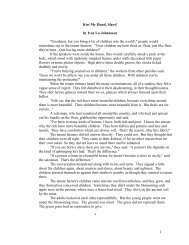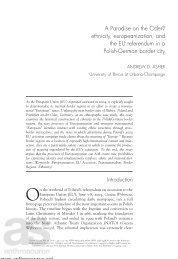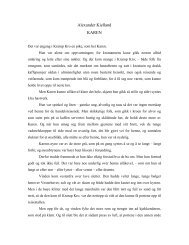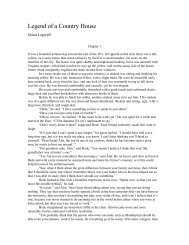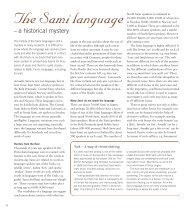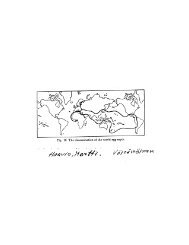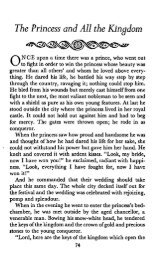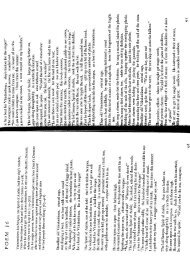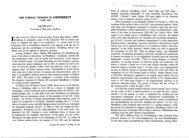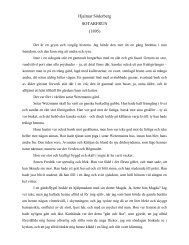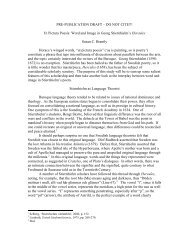Six Views of “The Little Mermaid” - Department of Scandinavian ...
Six Views of “The Little Mermaid” - Department of Scandinavian ...
Six Views of “The Little Mermaid” - Department of Scandinavian ...
You also want an ePaper? Increase the reach of your titles
YUMPU automatically turns print PDFs into web optimized ePapers that Google loves.
148<br />
SCANDINAVIAN STUDIES<br />
process, with the little mermaid representing his unconscious feminine<br />
element pis anima). Although Nyborg sees the prince as the protagonist <strong>of</strong><br />
the tale, one could argue that the mermaid is the central character and that<br />
the story relates her attempt at individuation, with the prince representing<br />
her animus. Such an interpretation would reveal the mermaid’s failed<br />
attempt at individuation. What thwarts her effort at wholeness is her<br />
repression and eventual annihilation <strong>of</strong> the feminine in an attempt to<br />
integrate the masculine.<br />
The sea world in which the little mermaid lives has the following<br />
qualities: it is female dominated (there is an almost entire absence <strong>of</strong> males);<br />
it is a world <strong>of</strong> death for humans; and its creatures (the mer-folk) tend to<br />
appear and be active at night. The sea, death, and night in Jungian terms are<br />
seen as female symbols. In this seemingly peaceful and contented world, the<br />
little mermaid is, however, unhappy. She longs to ascend to the human<br />
world. Jungian psychology <strong>of</strong>ten interprets the subject’s desire for another<br />
as the subject’s projection <strong>of</strong> hidher animalanimus. For example, the male<br />
subject projects his anima onto the female object, whereas the female subject<br />
projects her animus onto the male object. This projection <strong>of</strong>ten represents<br />
the subject’s desire “for all that one is not, consciously-but may be,<br />
unconsciously” (Singer 205). She yearns for the prince and the sun, which<br />
in Jungian terms is a traditionally male symbol. Indeed, her garden is even<br />
shaped like the sun, composed <strong>of</strong> red flowers (which are reminiscent <strong>of</strong> little<br />
suns) and a statue <strong>of</strong> a boy, which the rince happens to resemble. In<br />
Jungian terms, the strength <strong>of</strong> her desire P or the prince is characteristic <strong>of</strong><br />
the projection <strong>of</strong> the animus onto a male figure: <strong>“The</strong>refore animus and<br />
anima . . . are experienced primarily in a projected form in relationshi s<br />
between the sexes with a special quality <strong>of</strong> strength that transcends near f y<br />
all other human feelings” (Singer 205). The integration <strong>of</strong> masculine and<br />
feminine elements in the psyche is a quest for unity and wholeness. The fact<br />
that the prince and the little mermaid share the same birthday further<br />
emphasizes the possibility that the prince and the little mermaid may be<br />
considered two unintegrated aspects <strong>of</strong> self. The steps necessary to obtain<br />
the prince are, however, those that require the repression <strong>of</strong> the little<br />
mermaid’s own identity, for, by drinking the witch’s potion, she loses both<br />
her mermaid form and her voice. In the penultimate scene, the little<br />
mermaid throws the dagger into the sea, which turns red where the blade<br />
touches it. With this gesture the little mermaid is symbolically killing the<br />
feminine (the sea) with a phallic object (the dagger), representative <strong>of</strong> the<br />
masculine. A further indication that the feminine archetype in this case is<br />
overshadowed and destroyed by the masculine is the fact that the sunbeams<br />
bring death to the little mermaid: “den lille Havfrue lagde sine hvide Arme<br />
paa Reelingen og saae mod 0sten efter Morgenrden, den f~rrste Solstraale,<br />
vidste hun, vilde dmbe hende” [lo51 (the little mermaid leaned her white<br />
arms on the railing and looked eastward toward the red dawn; the first ray<br />
SPLASH! 149<br />
<strong>of</strong> sunlight, she knew, would kill her). Thus the little mermaid’s attempt at<br />
individuation fails. The wholeness and spirituality that result from psychic<br />
integration thus remain that which she still desires in the “daughters <strong>of</strong> the<br />
air” episode.<br />
Whether one takes a Freudian or Jungian approach to this text, what<br />
Seems to be at stake is the thwarted efforts <strong>of</strong> the female figure to develop<br />
and articipate fully in a patriarchal order. While Nyborg takes a psychobiograp<br />
R ical approach, viewing the prince as representing aspects <strong>of</strong> H. C.<br />
Andersen’s own development, one could argue that Andersen’s identification<br />
is instead with the little mermaid. Much like Freud, Andersen seems highly<br />
invested in rojecting his own fear <strong>of</strong> castration, or disempowerment, onto<br />
the female P igure <strong>of</strong> the mermaid. Her castration (loss <strong>of</strong> tongue, voice, and<br />
art) might represent Andersen’s own fear <strong>of</strong> losing his ability to express<br />
himself as an artist. Finally, the mermaid, in her persistent attempt to<br />
transcend her own origins and gain access to another world, might well<br />
reflect H. C. Andersen’s own entrapment in the position <strong>of</strong> outsider.<br />
Works Consulted<br />
Andersen, H. C. Euentyr. Vol. I Fortabfor Bern, 2835-2842. Ed. Erik Dal. Copenhagen: Hans<br />
Reitzels Forlag, 1963.<br />
Chodorow, Nancy. i’be Reproduction <strong>of</strong>hfothm‘ng. Berkeley: U <strong>of</strong> California P, 1978.<br />
Freud, Sigmund. Cidimtion und Its Discontents Trans. James Strachey. New York W. W.<br />
Norton, 1961.<br />
Mattoon, Mary Ann. Jungiun Psychology in Pmpmtivc New York: Free Press, 1981.<br />
Nyborg, Eigil. Den indre hie i H C Andm mgr. Copenhagen: GyldendaI, 1962.<br />
Singer, June. Boundaries <strong>of</strong> the Soul. Garden City, NY: Doubleday, 1972.<br />
Sprengnether, Madelon. i’be Spectrul Mother. Ithaca: Cornell UP, 1990.<br />
Strouse, Jean, ed. Women and Analysis: Diulogm on Psychoanalytic V k New York:<br />
Grossman, 1974.<br />
A Folktale/Disney Approach<br />
Niels and Faith Ingwersen<br />
University <strong>of</strong> Wisconsin, Madison<br />
A invoked by the genre, must inevitably pass one or a series <strong>of</strong> tests<br />
NY STUDENT <strong>of</strong> folklore will point to the importance <strong>of</strong> “the test” in<br />
the magic tale. Heroine or hero, according to the epic expectations<br />
to eliminate the lacks in her or his life and to earn the reward <strong>of</strong> living<br />
happily ever after with the sexual partner encountered on that “quest for<br />
fulfillment.”<br />
In the magic tale, the protagonists may initially fail the tests posed, but<br />
they ultimately rove their mettle. Hans Christian Andersen’s texts are<br />
strongly indebtel <strong>of</strong> course, to the folktale (and, in this case, to the magic<br />
tale), but the poetic narrative examined in this context, to a large degree,<br />
also echoes the undeserved sense <strong>of</strong> deprivation and utter isolation



